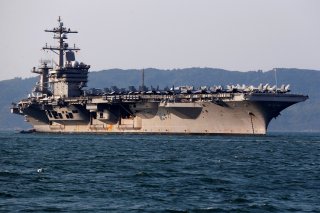This Aircraft Carrier Will Soon Have Stealth F-35 Joint Strike Fighters
The carrier has the speed, agility and maneuverability to travel more than five thousand nautical miles in less than seven days and still arrive on station ready to fight.
This week the USS Carl Vinson (CVN 70) departed Bremerton, Washington to commence sea trials as the final phase of the Nimitz-class nuclear-powered aircraft carrier’s seventeen-month “docking planned incremental availability” (DPIA) at Puget Sound Naval Shipyard and Intermediate Maintenance Facility. The supercarrier, which was launched in 1980 and undertook her maiden voyage in 1983, previously underwent a refueling and overhaul from 2005 to 2009.
The warship is now headed for her new homeport in San Diego, California.
As part of the seventeen-month dry dock repair period, the carrier was made ready for the Navy’s first F-35C Lightning II Joint Strike Fighter deployment, which is planned for next year. The F-35C modifications added classified spaces to the carrier but also replaced the carrier’s jet-blast deflectors. However, the warship’s current launch and recovery systems didn’t require special modifications to handle the Navy’s variant of the Joint Strike Fighter.
The U.S. Navy has announced plans to acquire some two hundred of the stealth fighters and equip each of its ten carrier air wings with one squadron of the radar-evading jets. It is worth noting that the Navy’s newer Gerald R. Ford-class carriers won’t be able to deploy the F-35C yet, so it is the aging Carl Vinson that is the first to receive the state-of-the-art aircraft.
Upgraded and Ready
Despite the fact that the Carl Vinson entered service during the Reagan era, the carrier’s upgrades will enable it to operate with the Navy’s most advanced fighter aircraft.
The DPIA included a complete restoration and system retrofit to accommodate the F-35C, while other upgrades included improved combat systems, electrical systems and crew living spaces. Maintenance was also conducted on the ship’s hull, rudders and shafts.
The ship is currently underway for sea trials and will arrive in its new homeport of San Diego, where it will begin the months-long training period to integrate the air wing and surface forces for the anticipated 2012 first operational deployment of the F-35C. The “Argonauts” of the Strike Fighter Squadron (VFA) 147 are expected to be the first of the F-35C squadrons to be deployed.
The carrier has the speed, agility and maneuverability to travel more than five thousand nautical miles in less than seven days and still arrive on station ready to fight.
Prior to departing Bremerton, the warship underwent extensive coronavirus prevention measures to ensure the health and safety of the crew while at sea, and to prevent potential spread to the crew’s families and the community upon the return to port.
“I am proud of all of the hard work and dedication shown by the entire crew throughout the DPIA—and particularly with the added challenges we faced during this pandemic,” said Capt. Matthew Paradise, Vinson’s commanding officer and a native of Tacoma, Washington. “Also, a huge thank you to our family and friends; because our success was, in large part, due to their unwavering support. We just couldn’t have done this without them.”
Very Active Duty
The carrier is named for the late Rep. Carl Vinson (D-Ga.), who represented his state in the House of Representatives for fifty-one years, where he earned the nicknamed “swamp fox” and “the Admiral” due to his interest in U.S. naval affairs. He served as chairman of the House Naval Affairs Committee in 1931 and played a pivotal role in guiding the U.S. Navy through World War II and the early Cold War. He was a strong supporter of the two-ocean navy act, which dramatically increased the naval budget by 70 percent.
USS Carl Vinson was deployed during Operational Desert Strike, Operation Iraqi Freedom, Operation Southern Watch and Operation Enduring Freedom. The body of terrorist leader Osama bin Laden was buried at sea in 2011 from the deck of the warship, while on Veterans Day 2011 the vessel hosted the first NCAA basketball game—the “Carrier Classic” between North Carolina and Michigan State—ever played on a navy aircraft carrier.
The carrier was also deployed twice to the Western Pacific in 2017 and 2018 respectively and was the carrier that supported the F-35C tests during the Rim of the Pacific 2018 exercise.
Peter Suciu is a Michigan-based writer who has contributed to more than four dozen magazines, newspapers and websites. He is the author of several books on military headgear including A Gallery of Military Headdress, which is available on Amazon.com.
Image: Reuters

